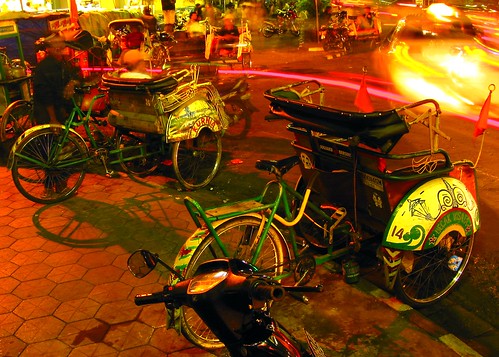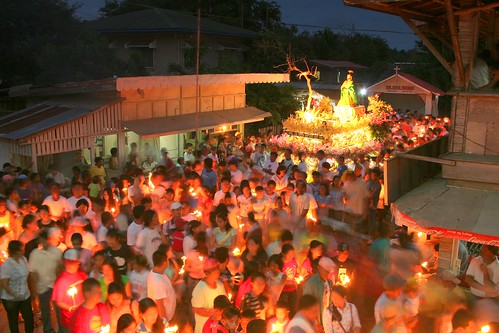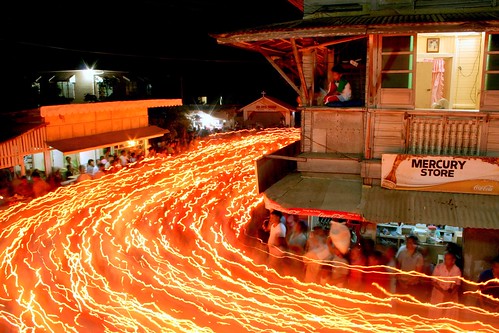Flower Shots for the Non-Flower Person
I have nothing against flowers but it is just not my style to populate and sow my flickr photostream with blooms. But today, in one of those rarefied moments called for by the occasion, I am posting a flower in flickr. This is in dedication to my mean sister, whom I and my meaner brother affectionately call Lall.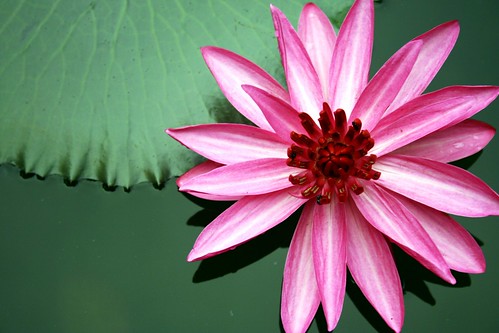
0.013s, f/5.6, 55 mm, ISO 200, +1/3 EV
Dakak, Dapitan, Zamboanga del Norte, the Philippines
Chemist that I am, I always approach photography like a laboratory experiment. This is not to say that I don’t succumb blissfully to the occasional stock photo syndrome. Case in point is the I-can-take-that-kinda-photo above. There is always something universally pleasing with a direct vertical-drop shot to isolate the starburst form of the lotus and frame it with an unblemished leaf floating on the lush moss-laden evergreen pond.
Colors and shapes will always be your friend. Here are a few more phototips.
Be aware of subject-background distance to create the DOF blur
Even with regular dSLR kit equipment – and I don’t have a macro lens – you can create the beautiful background blur by using the widest aperture. In terms of “f” value, the number must be at its lowest. The blur is visually most attractive, if the background is sufficiently far from the object. If too near, the background will be too sharp and distracting. If too far, the background will be just an indistinguishable haze. In the image below, I shot the flower with the purpose of making the pink makopa flowers on the ground blurry. The orange flower, the subject, was only secondary, and was chosen precisely because it was some distance from the ground, about 3 feet I guess. 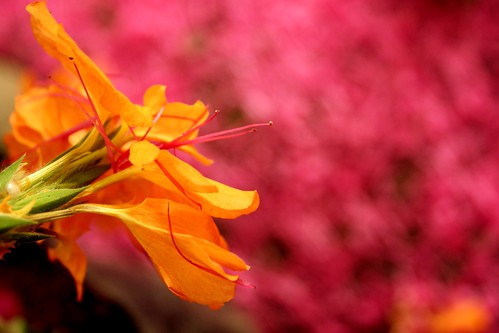
0.067 s, f/5.6, 41 mm, ISO 400, -1/3 EV
Talisay City, Cebu, the Philippines
There is actually an optics formula to calculate the desired distance of subject from background to create those little diamond-like compression spots or bokeh blur. I probably could improve the blur to make the spots more classically circular, but I was not in any mood to climb on a chair to photograph another flower more distant from the ground. In the real world, you take what you get.
Create varying background and foreground layers
Again, set the camera at its widest aperture to create the narrowest DOF (depth of field). For the kit lens of my Canon 350D rebel camera at 50mm, this would be f/1.8. Then, choose a flower subject that is crowded with other elements (other flowers, leaves, shrubs, whatever) that are several feet deep. The different layers behind (background) and before the subject (foreground) would then appear in varying levels of blur, from just unsharp near the point of focus to a complete blur at the field’s most distant end. The shot below is from a corner patch in Kobe where pansies were planted to form the word K-O-B-E. I have to bend and shoot along the direction of the row that is more than eight feet long. This is easier said than done without stepping into the flower patch. In this shot, the red pansy is in sharp focus and the others behind it blur out until they disappear completely.
0.005s, f/1.8, 50 mm, ISO 100, -1/3 EV
Kobe, Japan
Incorporate motion and use slow shutter speed
In my travels, me and my tripod are a happy pair. Even if flowers are my subject, I try to capture them in slow shutter speed and capture motion. If there is no movement, create it! One time after having breakfast in my hotel in Bali, I passed by a stairwell landing with standing basin of water strewn with rose petals. I could pictured it flat but the image would just be like a commercial spot for a spa. Then it came into me that I can create a whirlpool with my hand. I varied both the speed of manual swirling and the time of exposure and shot photos of various combinations. I found the shot at 2.5s taken at the top speed of the swirl to be quite fascinating - a vortex in red and pink.
2.5s, f/9, 28 mm, ISO 100, -1/3 EV
Nusa Dua, Bali, Indonesia
I still thought that there is one thing missing above. The whirl may resemble like a dreamlike giant rose but it lacks an anchor to deliver context. What, where and how the photo was taken? I then realized that the human element I can add is me. So I whipped the water aggressively, dipped my left hand to interrupt the water revolution and frame the shot. So here is my hand, as guilty as can be. 
0.6s, f/5, 27 mm, ISO 100, -1/3 EV
Nusa Dua, Bali, Indonesia
Now, while I was doing this, passersby must have thought of me mad. But I’ve done worst things other than playing with water. Like calling my brother and sister mean for instance.






